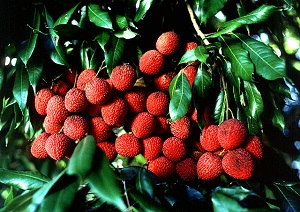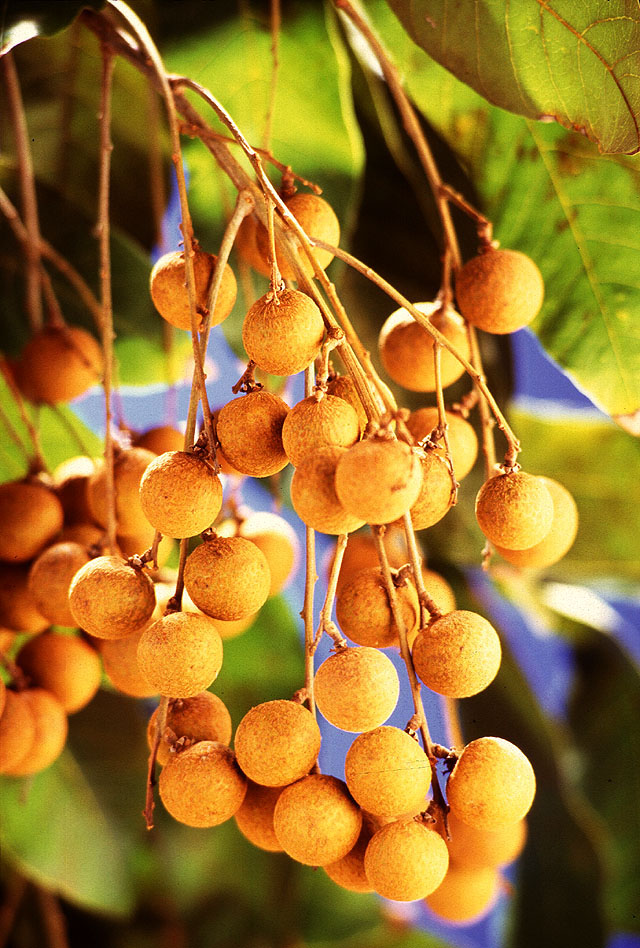From USDA-ARS
Subtropical Horticulture Research Laboratory
by Walter P. Gould, Raymond G. McGuire, and Jennifer L. Sharp
Florida Growers
Like Lychees and Longans
Published in the January 1998
issue of Agricultural Research magazine

Fig.1 
Lychees, Litchi
chinensis
A
seemingly unending string of hot, sunny days produces an ideal
environment for growing tropical and subtropical fruit at the southern
tip of Florida.
Two unusual tropical fruits—lychee
and longan—are now important commercial crops there. In 1996,
Florida growers harvested 1.37 million pounds of lychees, valued at
$2.75 million, and 875,000 pounds of longans worth $1.75 million.
Last
year, scientists at the Agricultural Research Service Subtropical
Horticulture Research Station in Miami, Florida, ensured the status of
these fruits as viable commercial crops by proving that neither the
longan nor the lychee hosts the dreaded Caribbean fruit fly.
Entomologists Michael K. Hennessey (now with the U.S. Environmental
Protection Agency) and Walter P. Gould were aided by entomologist
Jennifer L. Sharp and plant pathologist Raymond G. McGuire.
"Florida
lychee and longan growers ship their fruit throughout the United
States," says Hennessey. "But California had considered putting an
embargo on the fruit because it was thought capable of harboring the
Caribbean fruit fly."
Working with the Lychee and Longan
Committee of the Tropical Fruit Growers of South Florida, Inc.,
Hennessey and Gould developed a protocol that proved neither fruit to
be infested by this pest. It has been approved for use in California.
"This
could very easily have been a case of an internal quarantine of two
fruit crops that are easy to grow here in south Florida," Gould
explains. "But with the help of local growers, we proved that these
fruits pose no agricultural risks."

Fig. 2
Longans, Dimocarpus
longan
The
reddish-looking, exotic lychee, a favorite fruit in Southeast Asia, is
about the size of a walnut and easily peeled to expose sweet insides
that can be eaten fresh, canned, or dried. Also sweet tasting, longans
are about the size of grapes and grow in bunches. A hard, tan-colored
peel covers white fruit that clings to a single seed.
For the
research project, south Florida growers supplied fruit from six lychee
groves (Mauritius and Brewster varieties) on early-, mid-, and
late-season sampling dates. Of the 450 fruits collected, a third were
held as a control, while the remainder was exposed for a day to
numerous fertile female Caribbean fruit flies.
"We confirmed the
fertility of the flies by exposing them to guava, in which the flies
readily lay eggs," Gould explains. "We also made cuts on one group of
lychees, providing an enticing place for egg laying."
But, to no
avail. After exposure, the lychees were held for 30 days to allow time
for any eggs laid in the fruit to hatch and emerge as maggots.
"After
carefully inspecting each lychee, we found no maggots or larvae,
indicating that no eggs had been laid," says Gould. "During the 2-month
fruiting season, we also placed fly traps in each sample grove and
inspected them weekly. We found no flies."
Hennessey and
Gould repeated the procedure with Kohala longans—and again with
top-quality longans and lychees from the packinghouse.
"Again, we got the same results: no flies," Gould reports.
Using
guava as a control, Hennessey tried one more test: covering bunches of
longans and lychees on the trees with pollination bags holding five
fertile Caribbean fruit flies.
After 24 hours, there was no
evidence that the flies had infested the longans or lychees, but they
had attacked the guavas. After 30 days, there was still no sign of
attack on the longans or lychees, but the guavas were heavily infested.
As
a backup, in case the fruit had become infested, McGuire evaluated
fruit quality after irradiation and a cold treatment, developed by ARS,
of longans and lychees. Both fruits held up well under irradiation,
maintaining acceptable market quality. However, chilling caused surface
discoloration of longans.
"There's an expanding market for
tropical fruits, in part because health-conscious consumers are
including more fruits and vegetables in their diets and want a variety
to choose from," says Hennessey. "Our aim is to keep that supply
plentiful." — By Doris Stanley, Agricultural Research Service
Information Staff, 128 Smallwood Village Center, Waldorf, MD 20602.
Walter P. Gould, Raymond G. McGuire,
and Jennifer L. Sharp are at the USDA-ARS Subtropical Horticulture
Research Laboratory, 13601 Old Cutler Rd., Miami, FL 33158.
Back to
Lychee Page
Longan Page
|
|
Bibliography
Gould, Walter P., et al. "Florida
Growers Like Lychees and Longans". ars.usda.gov.
USDA, ARS, National Genetic Resources Program. Germplasm Resources
Information Network - (GRIN) [Online Database]. USDA-ARS
Subtropical Horticulture Research Laboratory, 13601 Old Cutler Rd.,
Miami, FL 33158. Jan. 1998. Web. 22 Mar. 2015.
Photographs
Fig. 1 Fitzgerald, Barry. Lychees,
Litchi chinensis. N.d. USDA, ARS, National Genetic Resources Program.
Germplasm Resources Information Network - (GRIN) [Online
Database]. USDA-ARS Subtropical Horticulture
Research Laboratory, 13601 Old Cutler Rd., Miami, FL 33158.
ars.usda.gov.
Web 22 Mar. 2015.
Fig. 2 Bauer, Scott. Longans,
Dimocarpus longan. N.d. USDA, ARS, National Genetic Resources Program.
Germplasm Resources Information Network - (GRIN) [Online
Database]. USDA-ARS Subtropical Horticulture
Research Laboratory, 13601 Old Cutler Rd., Miami, FL 33158.
ars.usda.gov.
Web 22 Mar. 2015.
Published 22 Mar. 2015 LR
|


